Related Research Articles

The Royal Australian Air Force (RAAF) is the principal aerial warfare force of Australia, a part of the Australian Defence Force (ADF) along with the Royal Australian Navy and the Australian Army. Constitutionally the Governor-General of Australia is the de jure Commander-in-Chief of the Australian Defence Force. The Royal Australian Air Force is commanded by the Chief of Air Force (CAF), who is subordinate to the Chief of the Defence Force (CDF). The CAF is also directly responsible to the Minister for Defence, with the Department of Defence administering the ADF and the Air Force.

No. 75 Squadron is a Royal Australian Air Force (RAAF) fighter unit based at RAAF Base Tindal in the Northern Territory. The squadron was formed in 1942 and saw extensive action in the South West Pacific theatre of World War II, operating P-40 Kittyhawks. It was disbanded in 1948, but reformed the following year and operated jet aircraft throughout the Cold War. The squadron was based at Malta from 1952 to 1954, flying de Havilland Vampires, and Malaysia from 1968 to 1983, with Dassault Mirage IIIs, before returning to Australia.
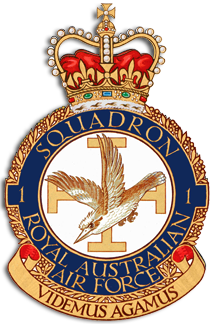
No. 1 Squadron is a Royal Australian Air Force (RAAF) squadron headquartered at RAAF Base Amberley, Queensland. It is controlled by No. 82 Wing, part of Air Combat Group, and is equipped with Boeing F/A-18F Super Hornet multi-role fighters.

No. 6 Squadron is a Royal Australian Air Force (RAAF) electronic attack squadron. It was formed in 1917 as a training unit based in England during World War I. The squadron was disbanded in 1919 but re-formed at the start of 1939. It subsequently saw combat as a light bomber and maritime patrol squadron during World War II, and took part in the New Guinea Campaign and New Britain Campaign before being disbanded after the war.
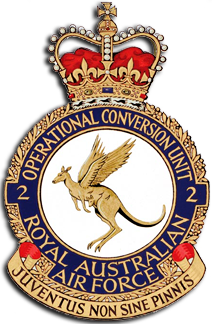
No. 2 Operational Conversion Unit is a fighter training unit of the Royal Australian Air Force (RAAF). Located at RAAF Base Williamtown, New South Wales, the unit trains pilots to operate the Lockheed Martin F-35 Lightning II. Pilots new to the F-35 enter No. 2 2OCU after first qualifying to fly fast jets at No. 79 Squadron and undertaking initial fighter combat instruction at No. 76 Squadron. Once qualified on the F-35, they are posted to one of No. 81 Wing's operational F-35 units, No. 3 Squadron, No. 75 Squadron or No. 77 Squadron.

No. 10 Squadron is a Royal Australian Air Force (RAAF) signals intelligence (SIGINT) squadron based at RAAF Base Edinburgh, South Australia. It is part of No. 92 Wing RAAF. The squadron was formed in 1939 as a maritime patrol unit. It saw active service during the Second World War, conducting anti-submarine operations and patrols from bases in the United Kingdom until it disbanded in late 1945. It was re-formed in Australia in 1949 and since then has contributed to Australia's East Timor intervention, and has been deployed to the Middle East as part of the War on Terrorism and the 2003 Gulf War. Most recently it now has a signals intelligence mission.

No. 4 Squadron is a Royal Australian Air Force squadron composed of the air force special forces Combat Controllers, aircrew who operate the Pilatus PC-21 aircraft and instructors for the Australian Defence Force Joint Terminal Attack Controller (JTAC) course.

No. 36 Squadron is a Royal Australian Air Force (RAAF) strategic transport squadron. It operates Boeing C-17 Globemaster III heavy airlifters from RAAF Base Amberley, Queensland. The squadron has seen active service flying transport aircraft during World War II, the Korean War, the Indonesia–Malaysia Konfrontasi, the Vietnam War, and the wars in Afghanistan and Iraq. It has also supported Australian humanitarian and peacekeeping operations around the world, including Somalia, Cambodia, East Timor and Indonesia.
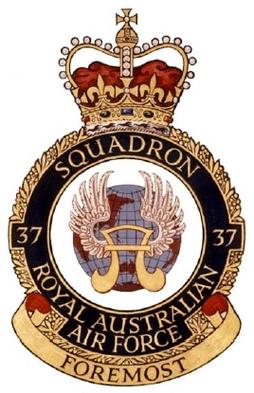
No. 37 Squadron is a Royal Australian Air Force (RAAF) medium tactical airlift squadron. It operates Lockheed Martin C-130J Hercules aircraft from RAAF Base Richmond, New South Wales. The squadron has seen active service flying transport aircraft during World War II, the Vietnam War, the wars in Afghanistan and Iraq, and the military intervention against ISIL. It has also supported Australian humanitarian and peacekeeping operations around the world, including in Somalia, East Timor, Bali, Papua New Guinea, and the Philippines.

No. 34 Squadron is a Royal Australian Air Force (RAAF) VIP transport squadron. It operates Boeing 737 Business Jets and Dassault Falcon 7Xs from Defence Establishment Fairbairn in Canberra. The squadron was formed in February 1942 for standard transport duties during World War II, initially flying de Havilland DH.84 Dragons in Northern Australia. In 1943 it re-equipped with Douglas C-47 Dakotas, which it operated in New Guinea and the Dutch East Indies prior to disbanding in June 1946.
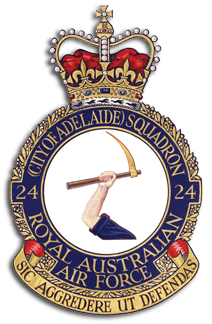
No. 24 Squadron is a Royal Australian Air Force squadron. The squadron was formed in 1940 and saw action as a bomber squadron during World War II serving in the Pacific theatre against the Japanese, and undertaking operations during the Battle of Rabaul, and the New Guinea, New Britain and Borneo campaigns. The squadron was disbanded in 1946 following the conclusion of hostilities, but was re-formed in 1951. From then until 2010 the squadron was an RAAF Reserve squadron located near Adelaide, South Australia; for part of this time, until 1960, the squadron continued to perform flying duties, before converting to a ground support role. In 2010, the squadron combined with Combat Support Unit Edinburgh to become a Permanent Air Force unit and it currently forms part of No. 96 Wing, Combat Support Group.
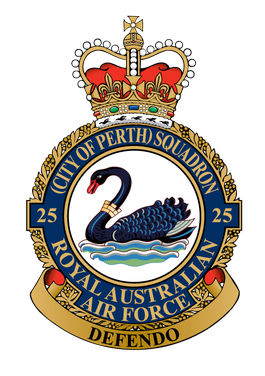
No. 25 Squadron is a general reserve squadron of the Royal Australian Air Force (RAAF). It is based at RAAF Base Pearce in Perth, Western Australia, and forms part of the Combat Support Group. The squadron was formed in early 1937 and until early 1939 was designated as No. 23 Squadron. During World War II, it provided local air defence for the Perth region, before undertaking Army co-operation duties in 1943–1944 and then converting to a heavy bomber role in 1945. Flying B-24 Liberators, the squadron took part in operations against Japanese targets in the Netherlands East Indies (NEI) and supported Allied ground operations during the Borneo Campaign.

Wing Commander Linda Mary Corbould, is a retired officer of the Royal Australian Air Force (RAAF), who was the first woman to command a RAAF flying squadron. She joined the RAAF in 1981, and became one of its first female pilots in the early 1990s. Corbould flew transport aircraft, including during the Iraq War in 2003, and commanded No. 36 Squadron from 2006 to 2008. She retired from the RAAF in 2011, but remains an officer in the Air Force Reserve.

No. 78 Squadron was a Royal Australian Air Force (RAAF) fighter squadron of World War II. It was formed in July 1943 as part of expansion of the RAAF's fighter force, and was assigned to mobile striking forces for the duration of the war.
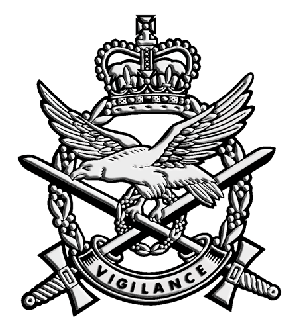
The Australian Army Aviation (AAAvn) is an administrative corps of the Australian Army. It was formed on 1 July 1968. The motto of the Australian Army Aviation corps is Vigilance.

No. 80 Squadron is a Royal Australian Air Force (RAAF) unit. It was first formed in September 1943 as a fighter squadron. After seeing action in the South West Pacific Theatre of World War II, the unit was disbanded in July 1946. The squadron was re-raised in April 2024 as the Australian component of a multinational unit responsible for developing software.
No. 1 Wing was an Australian Flying Corps (AFC) and Royal Australian Air Force (RAAF) wing active during World War I and World War II. The wing was established on 1 September 1917 as the 1st Training Wing and commanded the AFC's pilot training squadrons in England until April 1919, when it was disbanded. It was reformed on 7 October 1942 as a fighter unit comprising two Australian and one British flying squadrons equipped with Supermarine Spitfire aircraft, and a mobile fighter sector headquarters. The wing provided air defence to Darwin and several other key Allied bases in northern Australia until the end of the war, and was again disbanded in October 1945.

The Royal Australian Air Force (RAAF) operated McDonnell Douglas F/A-18 Hornet fighter aircraft between 1984 and 2021. The Australian Government purchased 75 A and B variants of the F/A-18 in 1981 to replace the RAAF's Dassault Mirage III fighters. The Hornets entered service with the RAAF between 1984 and 1990. Four Hornets were destroyed in flying accidents during the late 1980s and early 1990s.

Fighter Squadron was a flying unit of the Royal Australian Air Force (RAAF) in the early 1930s. It operated Bristol Bulldog single-seat fighters. Along with Seaplane Squadron, Fighter Squadron was a component of No. 1 Flying Training School, based at RAAF Point Cook, Victoria. As well as participating in training exercises, Fighter Squadron was frequently employed for aerobatic displays and flag-waving duties.
Robyn Clay-Williams is an Australian academic and one of the first two women to serve as pilots in the Royal Australian Air Force (RAAF). She joined the RAAF in 1979 and initially served in maintenance roles as women were not permitted to be pilots. After this restriction was lifted she completed pilot training in June 1988 and became a test pilot in 1993. Clay-Williams reached the rank of Wing Commander and led No. 85 Wing. After leaving the RAAF in 2003, she completed a doctorate. As of 2021, Clay-Williams was an associate professor at Macquarie University.
References
- 1 2 Aviation, Women in. "Emerging Leaders 2020 Meet our Guest Speakers" . Retrieved 17 September 2021.
- 1 2 3 4 Australia, Women in STEMM (20 December 2017). "STEMM PROFILE: Squadron Leader Marija Jovanovich | Test Pilot | Royal Australian Air Force | Adelaide | SA". Women in STEMM Australia. Retrieved 17 September 2021.
- 1 2 "Our eye in the sky". ABC Radio. 24 April 2019. Retrieved 17 September 2021.
- 1 2 Novak, Lauren (8 October 2019). "Stars in Her Eyes". The Advertiser.
- ↑ Duck, Siobhan (30 December 2006). "Top Guns". Herald Sun. p. W06.
- 1 2 Convenor, Gender Institute; convenor.genderinstitute@anu.edu.au. "Women in aerospace: taking advantage of diversity". genderinstitute.anu.edu.au. Retrieved 17 September 2021.
- ↑ Waldron2020-09-28T02:02:00+01:00, Greg. "RAAF wing commander charts a flight path for adventure". Flight Global. Retrieved 17 September 2021.
{{cite web}}: CS1 maint: numeric names: authors list (link) - ↑ Ghodsi, Roya (13 December 2021). "Air Force's ISREW specialists". Australian Defence Magazine. Retrieved 13 March 2022.
- ↑ "Australia Day 2019 Honours List | Governor-General of the Commonwealth of Australia". 25 January 2019. Archived from the original on 25 January 2019. Retrieved 17 September 2021.
- ↑ "RAAF No. 10 Squadron awarded Duke of Gloucester Cup 2021". Australian Aviation. Retrieved 17 September 2021.
- ↑ Tupas, Nastasha (5 August 2021). "RAAF No.10 Squadron awarded Duke of Gloucester Cup 2021". www.defenceconnect.com.au. Retrieved 17 September 2021.